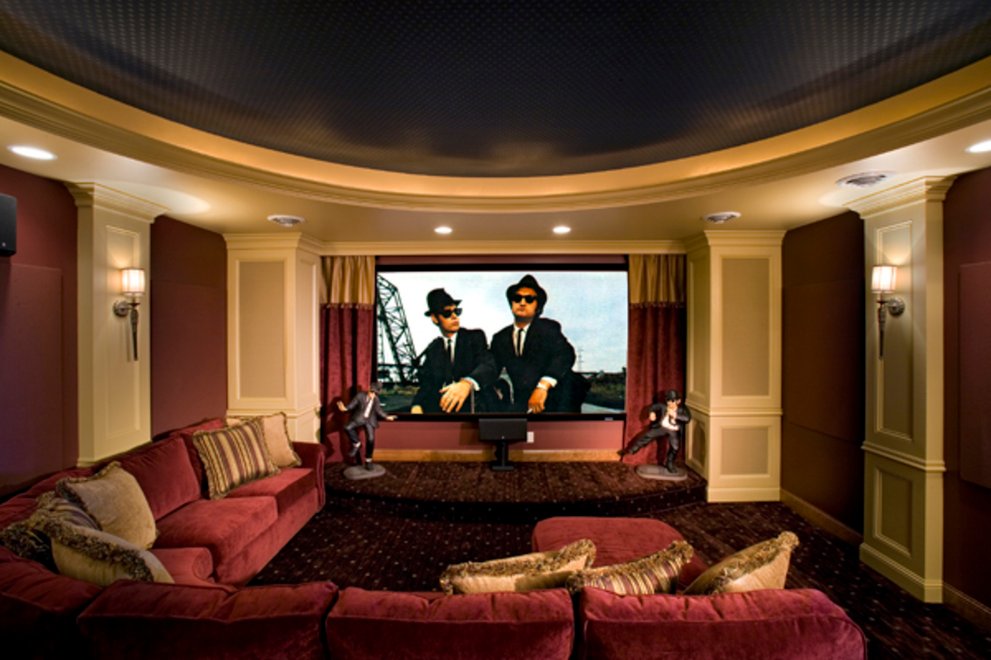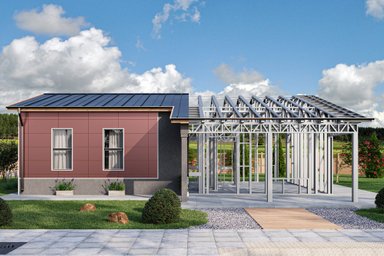The big game is coming, your friends and family
are on their way….Here are some of the features you should
consider when designing a media room for enjoyable viewing and listening. The example above is from Plan 51-414.
Screen Size. The screen should be large enough for everyone in the room to view it from a good angle. To assure this, take the diagonal distance across the screen and multiply it by two or three to get the maximum distance from seats to screen.
Projector vs. Television. Both have their advantages. With projectors one can have a very large screen size and a softer glow than a TV. A projector system, however, requires complete control of room lighting as even a little ambient lighting will wash out the image on the screen. Flat screen televisions are a little more straightforward and large enough for most home media rooms.
Sound Absorption and Sound Transmission. It is important to control the amount of sound entering to and leaking from the room. This can be done by the use of sound absorbing sheet rock on the walls and sound dampening materials on the ceiling. For walls, use Quiet Rock or a similar drywall product and make sure the material is at least 5/8” thick. Ceiling sound can be controlled in several ways. Standard fiberglass panels and a drop ceiling will dampen a certain amount of sound as will adding fiberglass insulation between the ceiling and the floor above. For the greatest sound control consider adding Accoustic Panels to both walls and ceiling. Accoustic panels inhibit reflected sound that can make speech sound garbled and music discordant; they can be made from dense fiberglass material and should be at least 2” in thickness. These panels are readily available on-line and cost around $50 for a 24” X 36” panel. Sound can also be controlled on the floor by the use of carpet and padding. Carpet absorbs sound well and does a good job dampening reflected sound.
Lighting. It should be controlled by a dimmer switch and heavy curtains or room darkening shades. You’ll want some light in the room but not enough to affect the screen.
Speakers/ Surround-Sound. Speakers are a big subject, but generally media rooms sound best when using a surround- sound system. Surround-sound comes in 5 or 7 speaker configurations. The 5 speaker systems do a good job of achieving an immersive experience. Check your local audio store or on line for detailed advice on speakers.
Framing. Make sure that framing is in the right locations for mounting the TV or projector and any wall- or ceiling-mounted speakers.
Surge Protector. Protect your audio and video equipment with a surge protector. Surge protectors block spikes in electricity that can damage equipment. Internet and phone wires should also be protected. For the most protection, add a surge protector directly to your electrical panel as well as one in your media closet just upstream of your equipment.
Cables. To transmit the video signal to your TV or projector, make sure to buy cables that match your equipment. The best quality signal is transmitted by HDMI or DVI cable. Other standards sometimes require different formats You’ll want to run all your cable, install your speakers, and test the system before Installing sheet rock and ceiling panels. Be sure to run your cables through conduit and include a fish line so cables can be changed as equipment changes down the road.
Audio Video Receiver. An Audio Video Receiver allows all your video and audio inputs to be connected to the receiver with only one video connection needed to connect to your TV. Most AV receivers have one or more surround-sound systems in either 5 speaker or 7 speaker formats for your audio output.
Now that you’ve planned everything, your media room is ready for the Big Game!
Screen Size. The screen should be large enough for everyone in the room to view it from a good angle. To assure this, take the diagonal distance across the screen and multiply it by two or three to get the maximum distance from seats to screen.
Projector vs. Television. Both have their advantages. With projectors one can have a very large screen size and a softer glow than a TV. A projector system, however, requires complete control of room lighting as even a little ambient lighting will wash out the image on the screen. Flat screen televisions are a little more straightforward and large enough for most home media rooms.
Sound Absorption and Sound Transmission. It is important to control the amount of sound entering to and leaking from the room. This can be done by the use of sound absorbing sheet rock on the walls and sound dampening materials on the ceiling. For walls, use Quiet Rock or a similar drywall product and make sure the material is at least 5/8” thick. Ceiling sound can be controlled in several ways. Standard fiberglass panels and a drop ceiling will dampen a certain amount of sound as will adding fiberglass insulation between the ceiling and the floor above. For the greatest sound control consider adding Accoustic Panels to both walls and ceiling. Accoustic panels inhibit reflected sound that can make speech sound garbled and music discordant; they can be made from dense fiberglass material and should be at least 2” in thickness. These panels are readily available on-line and cost around $50 for a 24” X 36” panel. Sound can also be controlled on the floor by the use of carpet and padding. Carpet absorbs sound well and does a good job dampening reflected sound.
Lighting. It should be controlled by a dimmer switch and heavy curtains or room darkening shades. You’ll want some light in the room but not enough to affect the screen.
Speakers/ Surround-Sound. Speakers are a big subject, but generally media rooms sound best when using a surround- sound system. Surround-sound comes in 5 or 7 speaker configurations. The 5 speaker systems do a good job of achieving an immersive experience. Check your local audio store or on line for detailed advice on speakers.
Framing. Make sure that framing is in the right locations for mounting the TV or projector and any wall- or ceiling-mounted speakers.
Surge Protector. Protect your audio and video equipment with a surge protector. Surge protectors block spikes in electricity that can damage equipment. Internet and phone wires should also be protected. For the most protection, add a surge protector directly to your electrical panel as well as one in your media closet just upstream of your equipment.
Cables. To transmit the video signal to your TV or projector, make sure to buy cables that match your equipment. The best quality signal is transmitted by HDMI or DVI cable. Other standards sometimes require different formats You’ll want to run all your cable, install your speakers, and test the system before Installing sheet rock and ceiling panels. Be sure to run your cables through conduit and include a fish line so cables can be changed as equipment changes down the road.
Audio Video Receiver. An Audio Video Receiver allows all your video and audio inputs to be connected to the receiver with only one video connection needed to connect to your TV. Most AV receivers have one or more surround-sound systems in either 5 speaker or 7 speaker formats for your audio output.
Now that you’ve planned everything, your media room is ready for the Big Game!






